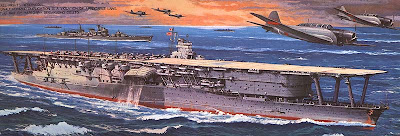Countdown to Midway: 27 May 1942
On board the new battleship, Yamato, a final round of planning and wargaming had wrapped on the 25th, uncovering some potentially fatal flaws with Yamamoto’s plan – namely that there was a gap in the air search pattern south of the Hawaii/Midway axis which would prevent detection of American forces if they sortied to that area. Other officers were concerned that Nagumo’s forces were too far removed from the main body should additional support be required. However, Nagumo and his staff assured Yamamoto that they would be able to handle any such contingency, but another problem had arisen – namely that elements of Kido Butai would not be ready to sail on the established date.
Parshall & Tully note that Yamamoto declined to make changes in the operational schedule, believing that the tides at Midway would not accommodate Nagumo’s tardiness. Kido Butai would sail a day after the rest of the forces (invasion convoy and supporting force) and as such, would have one day less to knock out the island’s defenses for the invading force. No changes were made to the operational plan – no contingency plans put in effect. On the eve of departure for what the IJN leadership viewed to be the deciding battle, the battle that would utterly destroy the American fleet and end America’s presence in the Pacific, thereby securing the Greater East Asia Co-Prosperity Sphere, the planning and wargaming was almost a polar opposite of the tightly scripted, minutely detailed effort that led to the attack at Pearl Harbor.
Around the world, forces were joined and movement was afoot in this truly global war. In
“‘I want you to be specific,’ Nimitz said, fixing me with his cool blue eyes. ‘After all, this is the job I have given you – to be the admiral commanding the Japanese forces, and tell me what is going on.’
It was a tall order, given that so much was speculation rather than hard fact. I knew that I would have to stick my neck out, but that was clearly what he wanted. Summarizing all my data, I told Nimitz that the carriers would probably attack on the morning of 4 June, from the north-west on a bearing of 325 degrees. They could be sighted at about 175 miles from Midway at around 0700 hours local time.
On the strength of this estimate, Admiral Nimitz crossed his Rubicon on 27 May 1942…I knew very well the extent to which Nimitz had staked the fate of the Pacific Fleet on our estimates, and his own judgment, against those of Admiral King and his staff in Washington.” – …And I was There (Ed Layton) 1985, pg. 430.




